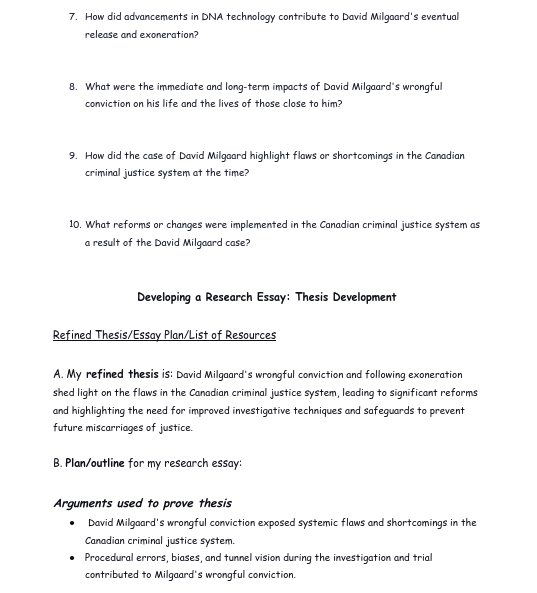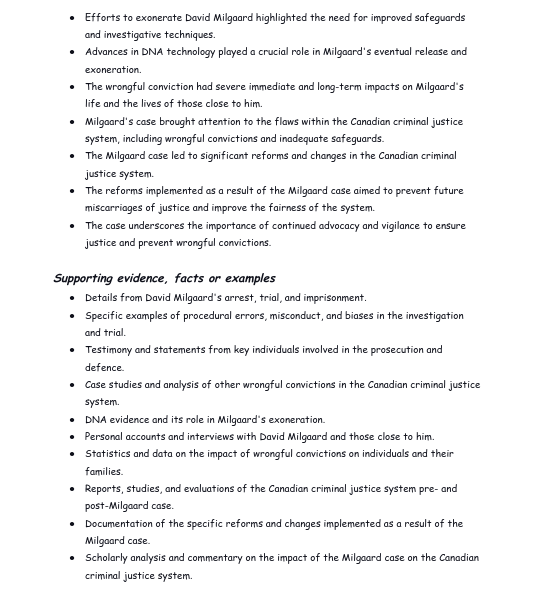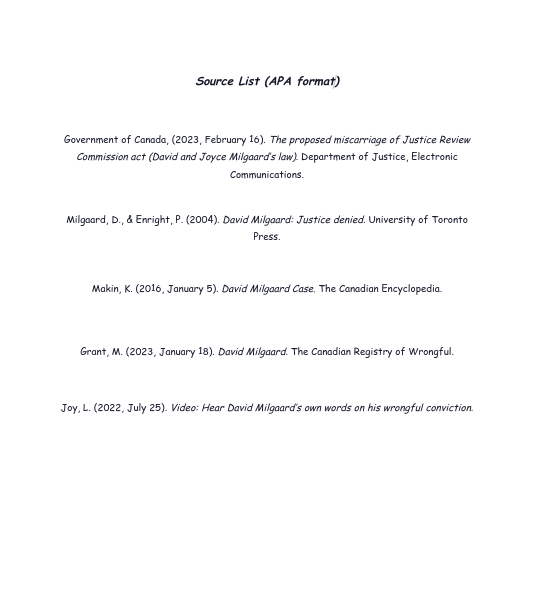Question
David Milgaard's Wrongful Conviction: Exposing Flaws and Driving Reforms in the Canadian Criminal Justice System The wrongful conviction and subsequent exoneration of David Milgaard stand
David Milgaard's Wrongful Conviction: Exposing Flaws and Driving Reforms in the Canadian Criminal Justice System
The wrongful conviction and subsequent exoneration of David Milgaard stand as a stark example of the flaws within the Canadian criminal justice system. Milgaard's case shed light on procedural errors, biases, and tunnel vision that led to his wrongful conviction. Efforts to exonerate him highlighted the need for improved safeguards and investigative techniques. Advances in DNA technology played a crucial role in his eventual release. This essay explores the impacts of Milgaard's wrongful conviction, the shortcomings of the Canadian criminal justice system at the time, and the reforms and changes that resulted from his case. He was young man with no criminal record, was wrongfully convicted of the rape and murder of Gail Miller. Milgaard was implicated in the crime based on circumstantial evidence, including witness misidentification and alleged sightings of a suspect matching his description. The trial took place in 1970 in Saskatoon, Saskatchewan, and the evidence presented against Milgaard included witness testimonies and a sketch that resembled him.
The investigation and trial process in Milgaard's case were marred by procedural errors and misconduct. The police investigation displayed tunnel vision, focusing solely on Milgaard as the primary suspect while disregarding other potential leads and evidence that could have proven his innocence. Biases within the justice system also played a role, as the investigators and prosecutors failed to critically evaluate the evidence and consider alternative explanations. During his 23-year imprisonment, Milgaard and his supporters tirelessly worked to prove his innocence. They faced numerous challenges, including legal barriers, skepticism from the public, and a reluctance from authorities to review the case. Advocacy groups, lawyers, and public support played a vital role in bringing attention to Milgaard's wrongful conviction and pushing for a reevaluation of the evidence.
Advancements in DNA technology played a pivotal role in Milgaard's eventual release and exoneration. In 1992, DNA analysis conclusively excluded Milgaard as the source of the crime scene evidence. The use of DNA evidence highlighted the fallibility of traditional investigative techniques and reinforced the need for objective and scientific approaches to criminal investigations.
Milgaard's wrongful conviction had severe immediate and long-term impacts on his life and the lives of those close to him. He endured the emotional and psychological toll of wrongful imprisonment, facing isolation, loss of personal and educational opportunities, and a tainted reputation. The wrongful conviction also had a profound effect on the families of both Milgaard and the victim, who experienced immense pain and suffering.
The Milgaard case exposed significant flaws within the Canadian criminal justice system. Wrongful convictions, inadequate investigative techniques, and biases within the system were brought to the forefront. The reliance on circumstantial evidence, witness misidentification, and a lack of checks and balances contributed to Milgaard's wrongful conviction. In response to the Milgaard case and other miscarriages of justice, the Canadian criminal justice system underwent significant reforms. New investigative protocols, such as the establishment of independent review bodies and improved safeguards against tunnel vision and biases, were implemented. These reforms aimed to prevent future wrongful convictions and improve the fairness and reliability of the system. David Milgaard's wrongful conviction exposed the flaws in the Canadian criminal justice system, leading to significant reforms and highlighting the need for improved investigative techniques and safeguards. Procedural errors, biases, and tunnel vision during the investigation and trial contributed to his wrongful conviction. Efforts to exonerate Milgaard emphasized the importance of continued advocacy and vigilance in the pursuit of justice. The advancements in DNA technology played a crucial role in his eventual release and highlighted the fallibility of traditional investigative methods. The reforms implemented as a result of the Milgaard case aimed to prevent future miscarriages of justice and improve the fairness and reliability of the Canadian criminal justice system.
This is my Essay based on David Milgaard and his wrongful conviction, please make it formal (an introduction paragraph that presents topic and thesis statement, a body of 3 paragraphs containing in-depth analysis and arguments, and a conclusion wrapping up ideas and relating back to thesis). Make it into 1250-1750 words. Well detailed and well formatted. I added the background info and first steps I took to getting here.




Step by Step Solution
There are 3 Steps involved in it
Step: 1

Get Instant Access to Expert-Tailored Solutions
See step-by-step solutions with expert insights and AI powered tools for academic success
Step: 2

Step: 3

Ace Your Homework with AI
Get the answers you need in no time with our AI-driven, step-by-step assistance
Get Started


